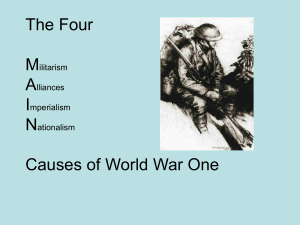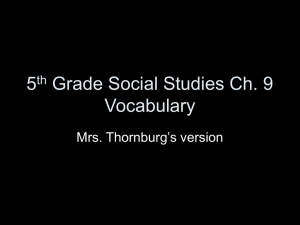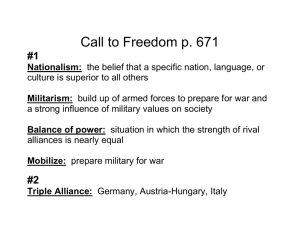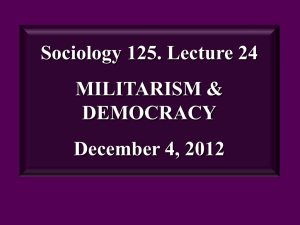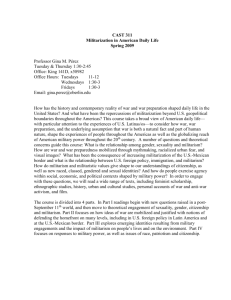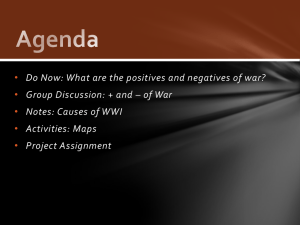Countering Militarism through Peace Education
advertisement
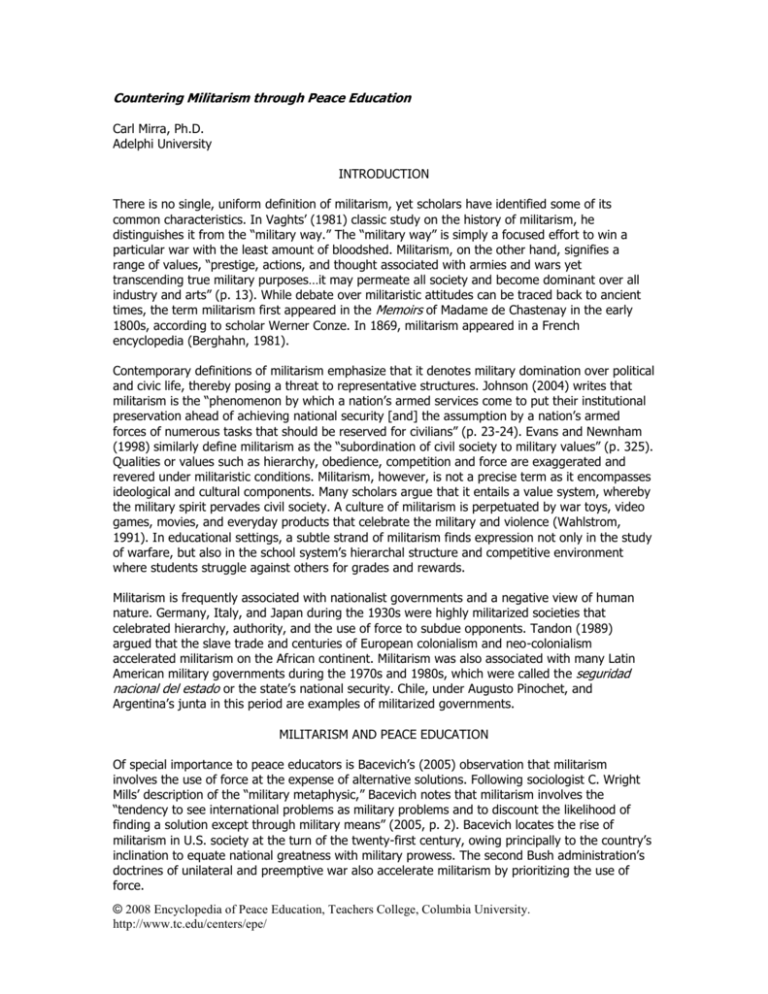
Countering Militarism through Peace Education Carl Mirra, Ph.D. Adelphi University INTRODUCTION There is no single, uniform definition of militarism, yet scholars have identified some of its common characteristics. In Vaghts’ (1981) classic study on the history of militarism, he distinguishes it from the “military way.” The “military way” is simply a focused effort to win a particular war with the least amount of bloodshed. Militarism, on the other hand, signifies a range of values, “prestige, actions, and thought associated with armies and wars yet transcending true military purposes…it may permeate all society and become dominant over all industry and arts” (p. 13). While debate over militaristic attitudes can be traced back to ancient times, the term militarism first appeared in the Memoirs of Madame de Chastenay in the early 1800s, according to scholar Werner Conze. In 1869, militarism appeared in a French encyclopedia (Berghahn, 1981). Contemporary definitions of militarism emphasize that it denotes military domination over political and civic life, thereby posing a threat to representative structures. Johnson (2004) writes that militarism is the “phenomenon by which a nation’s armed services come to put their institutional preservation ahead of achieving national security [and] the assumption by a nation’s armed forces of numerous tasks that should be reserved for civilians” (p. 23-24). Evans and Newnham (1998) similarly define militarism as the “subordination of civil society to military values” (p. 325). Qualities or values such as hierarchy, obedience, competition and force are exaggerated and revered under militaristic conditions. Militarism, however, is not a precise term as it encompasses ideological and cultural components. Many scholars argue that it entails a value system, whereby the military spirit pervades civil society. A culture of militarism is perpetuated by war toys, video games, movies, and everyday products that celebrate the military and violence (Wahlstrom, 1991). In educational settings, a subtle strand of militarism finds expression not only in the study of warfare, but also in the school system’s hierarchal structure and competitive environment where students struggle against others for grades and rewards. Militarism is frequently associated with nationalist governments and a negative view of human nature. Germany, Italy, and Japan during the 1930s were highly militarized societies that celebrated hierarchy, authority, and the use of force to subdue opponents. Tandon (1989) argued that the slave trade and centuries of European colonialism and neo-colonialism accelerated militarism on the African continent. Militarism was also associated with many Latin American military governments during the 1970s and 1980s, which were called the seguridad nacional del estado or the state’s national security. Chile, under Augusto Pinochet, and Argentina’s junta in this period are examples of militarized governments. MILITARISM AND PEACE EDUCATION Of special importance to peace educators is Bacevich’s (2005) observation that militarism involves the use of force at the expense of alternative solutions. Following sociologist C. Wright Mills’ description of the “military metaphysic,” Bacevich notes that militarism involves the “tendency to see international problems as military problems and to discount the likelihood of finding a solution except through military means” (2005, p. 2). Bacevich locates the rise of militarism in U.S. society at the turn of the twenty-first century, owing principally to the country’s inclination to equate national greatness with military prowess. The second Bush administration’s doctrines of unilateral and preemptive war also accelerate militarism by prioritizing the use of force. © 2008 Encyclopedia of Peace Education, Teachers College, Columbia University. http://www.tc.edu/centers/epe/ Militarism need not find expression in warfare alone. War preparedness contributes mightily to militaristic sensibilities. A thriving war industry adds to a militarized world. It is estimated that the major powers alone possess some 30,000 nuclear weapons and global arms spending was roughly U.S. $55.8 billion annually at the turn of the twenty-first century (Menon, 2001). Peace researchers have demonstrated that massive arms spending while human needs are unmet constitute structural violence, since expenditures on arms come at the expense of human needs. Militarism thrives on insecurity, anxiety and fear, thereby allowing resources to be diverted from education, health care and related needs. The World Council of Churches has argued that humanity might have avoided the disaster of nuclear war, but not the disaster of malnutrition, educational neglect and lack of health care (Reardon, 1982). These problems are exacerbated by military spending that diverts badly-needed resources to excessive military preparedness. This phenomenon is related to the “military-industrial complex,” a term coined by U.S. President Dwight Eisenhower in 1961. The president warned that the confluence of the private defense industry with the government led to the “mindless pursuit” of “redundant weapons systems” (Roland, 2001, p. 5). Mills’ (1956) formulation of a “power elite” that adopted a military mindset expands Eisenhower’s concept to include how economic priorities propel militaristic attitudes. Peace educators paid particular attention to militarism during the Cold War and its attendant arms race. Disarmament education was offered as an alternative to the rising tide of militarism and war preparations. Following the Second World War, the Soviet Union and the United States engaged in an intense rivalry from roughly 1947 to 1991. This period was animated by the threat of nuclear war and war preparedness on a global scale. In 1978, the United Nations Educational, Scientific and Cultural Organization (UNESCO) first promoted “disarmament education” as a remedy to a culture of militarism. The 10th Special Session of the United Nations General Assembly encouraged UNESCO’s disarmament education plan, having argued that students must be provided with the tools to “resist propaganda for war and militarism” (UNGA, 1978). UNESCO subsequently held a World Congress on Disarmament Education in 1979. Magnus Haavelsrud, a professor of peace education, collected the Congress’ work in an edited volume titled Approaching Disarmament Education, which countered “present developments of militarism and suppression” (Haavelsrud, 2004, pp. v, 1-2). Reardon’s (1996) observation that militarism is connected to patriarchy has significantly enhanced the field of peace education in understanding both concepts. She has written that militarism is a “belief system” based on the presupposition that “human beings are by nature violent, aggressive and competitive” (p. 145). Militarism, then, is a value system where civic virtue is conflated with service in the armed forces or more generally with the use of power and force to subdue adversaries. Militarism and sexism are inseparable, Reardon discovered. Galtung’s (1996) suggestion that ninety-five percent of direct, physical violence is committed by males seems to support Reardon’s insistence that militarism and sexism are interrelated. The war system, as Reardon calls it, shares the same core values of patriarchal institutions. Fears of losing control or maintaining dominance are mental frameworks that are common among sexism and militarism. Both patriarchy and the war system exaggerate the qualities of hierarchy, force, coercion, and the preoccupation with protecting oneself against a hostile adversary and/or competitors. According to Reardon, peace educators cannot address the problem of militarism without addressing the problem of sexism. Peace education aims to reverse the adverse effects of militarism in many ways. The field promotes conflict resolution skills in individuals, schools and international relations as outlined in Reardon and Cabezudo (2002). Moreover, peace researchers have contributed a more balanced view of the human being beyond the militaristic view of human nature as aggressive and hypercompetitive. During the United Nation’s International Year of Peace in 1986, leading scientists released “The Seville Statement on Violence.” The scientists concluded that, “it is 2 scientifically incorrect to say that war is caused by instinct,” and “there are cultures which have not engaged in war for centuries” (Wahlstrom, 1991, pp. 30-31). Grossman (1996) has likewise reported that a U.S. Army study during the Second World War discovered that only fifteen to twenty percent of soldiers would fire their weapon. The general who conducted the study concluded that these soldiers possessed an “inner and usually unrealized resistance toward killing” (Grossman, 1996, p.1). In addition to countering the pessimistic conception of human nature, peace researchers work to highlight the link between the oppression of women and the militaristic spirit that seeks to subjugate perceived enemies. LOOKING FORWARD Several organizations have worked to promote a culture of peace for the twenty-first century. UNESCO has sponsored The International Decade for a Culture of Peace and Non-Violence for the Children of the World (2001 to 2010). The Hague Agenda for Peace and Justice (2000) aimed to uncover the root causes of war and militarism, while facilitating peacemaking skills. Redefining human security with regard to environmental and human needs rather than nationalistic imperatives and promoting universal human rights are among the appeal’s many initiatives to build a peaceful world. The goals of these various efforts are to replace a culture of militarism with a culture of peace. REFERENCES Bacevich, A. (2005). The new American militarism: How Americans are seduced by war. Oxford, UK: Oxford University Press. Berghahn, V. (1981). Militarism: The history of an international debate, 1861-1979. Cambridge, UK: Cambridge University Press. Evans, G. & Newnham, J. (1998). The Penguin dictionary of international relations. London, UK: Penguin Books. Galtung, J. (1996). Peace by peaceful Means: Peace and conflict, development and civilization . London, UK: Sage Publications. Grossman, D. (1996). On killing. New York, NY: Back Bay Books. Haavelsrud, M. (2004). Target: Disarmament education. Journal of Peace Education, 1(1), 37-57. Johnson, C. (2004). The sorrows of empire: Militarism, secrecy and the end of the republic. New York, NY: Henry Holt. Menon, B. (2001). Disarmament education: A basic guide. New York, NY: United Nations/NGO Committee on Disarmament Affairs. Mills, C. (1956). The power elite. Oxford, UK: Oxford University Press. Reardon, B. & Cabezudo, A. (2002). Learning to abolish war: Teaching toward a culture of peace. New York, NY: Hague Appeal for Peace. Reardon, B. (1982). Militarization, security and peace education: A guide for concerned citizens . Valley Forge, PA: United Ministries in Education. 3 _______ (1996). Militarism and sexism: Influences on education for war. In R. Burns and R. Aspeslagh (Eds.), Three decades of peace education around the world. New York, NY: Garland Publishing. Roland, A. (2001). The military-industrial complex. Washington, D.C.: American Historical Association. Tandon, Y. (1989). Militarism and peace education in Africa: A guide and manual for peace education in Africa. Nairobi, Kenya: African Association for Literacy Education. UNGA. (1978). Final Document of the Tenth Special Session of the General Assembly , 27th Session, June 30, 1978. Vagts, A. (1981). A history of militarism. (Rev. ed.). Westport, CT: Greenwood Press. Wahlstrom, R. (1991, March). Peace education meets the challenge of the cultures of militarism. Peace Education Miniprints No. 11. Lund University, Sweden: Malmo School of Education. 4

